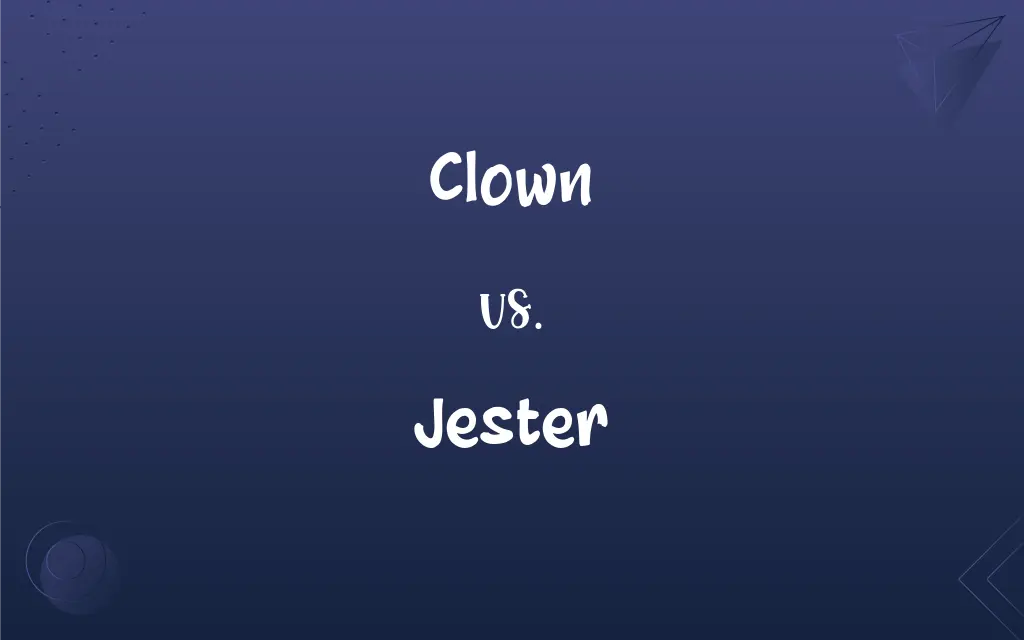Clown vs. Jester: What's the Difference?
Edited by Aimie Carlson || By Harlon Moss || Published on January 26, 2024
Clowns are performers in circuses or entertainment who use physical comedy and exaggerated features to amuse; jesters are historical entertainers in royal courts, known for their wit and storytelling.

Key Differences
Clowns emerged as comic performers in circuses, primarily entertaining through physical comedy and absurd antics, often characterized by their colorful makeup and costumes. Jesters, in contrast, have historical roots in medieval courts, serving as entertainers for royalty and nobility, using their wit, storytelling, and musical skills to amuse and sometimes offer veiled criticism or advice.
The primary role of a clown is to amuse and entertain audiences through exaggerated, often slapstick humor. They are a staple in circuses and can be seen in modern entertainment forms like movies and television. Jesters, on the other hand, were multifaceted entertainers in royal courts, not only providing humor but also often playing the role of an advisor or critic, using their humor to influence decisions and provide insight.
Clowns are easily recognizable by their distinctive makeup, oversized clothing, and colorful wigs, designed to exaggerate their expressions and movements for comedic effect. Jesters typically wore brightly colored attire, including a hat with bells and a motley pattern, but their appearance was less exaggerated than that of clowns, often reflecting the fashion of the court they served in.
In modern culture, clowns are often associated with children's entertainment but also have a dual perception due to their portrayal in horror media. Jesters, although not commonly present in contemporary entertainment, are often romanticized in literature and film, viewed as clever, insightful characters who could speak truths others could not.
The evolution of clowns has led to various forms, from traditional circus clowns to modern comedic characters in various media. The legacy of jesters, while not directly present in modern entertainment, lives on in the archetype of the wise fool, a character who uses humor and wit to convey wisdom and critique society.
ADVERTISEMENT
Comparison Chart
Origin
Circus entertainment
Medieval royal courts
Primary Role
Physical comedy, amusement
Entertainment, wit, subtle advice
Costume and Appearance
Exaggerated makeup, colorful attire
Motley pattern, hat with bells
Cultural Role
Entertainment, children's parties
Royal advisor, social commentator
Contemporary Presence
Circuses, media, horror genres
Historical references, literary tropes
ADVERTISEMENT
Clown and Jester Definitions
Clown
A clown is an entertainer who uses physical comedy to amuse audiences.
At the party, the clown's antics had everyone in stitches.
Jester
A jester was a versatile performer in medieval courts, adept at music, comedy, and storytelling.
The jester played the lute and sang songs that made the courtiers laugh.
Clown
A clown is a circus performer known for comedic acts and exaggerated appearance.
The clown juggled wildly, making the children laugh.
Jester
A jester is often portrayed as a wise fool, using humor to convey wisdom.
In the play, the jester's witty remarks held deeper truths.
Clown
A clown is a figure often associated with circuses and children's entertainment.
The clown made balloon animals, delighting the kids at the fair.
Jester
A jester is a historical entertainer in royal courts known for wit and storytelling.
The jester's clever tales entertained the king and his court.
Clown
A clown is a character in various forms of entertainment characterized by colorful makeup and clothing.
The clown in the movie brought both laughter and tears to the audience.
Jester
A jester, in history, sometimes played the role of an informal advisor to royalty.
The jester's subtle advice often influenced the king's decisions.
Clown
A clown is a symbol of humor and joy in popular culture.
The clown balloon floated above the parade, bringing smiles to the crowd.
Jester
A jester is a cultural icon representing cleverness and the ability to speak truth through humor.
The jester in the novel symbolized the power of satire in society.
Clown
A buffoon or jester who entertains by jokes, antics, and tricks in a circus, play, or other presentation.
Jester
One given to jesting.
Clown
One who jokes and plays tricks.
FAQs
Where did jesters perform?
Jesters performed in medieval royal courts.
What is a jester?
A jester was a historical entertainer in royal courts, known for wit and storytelling.
Are clowns always humorous?
Clowns primarily aim to be humorous, but their portrayal can vary.
What did jesters wear?
Jesters wore motley attire with a bell-adorned hat.
Did jesters only tell jokes?
Jesters told jokes, but also provided storytelling, music, and sometimes advice.
What's distinctive about a clown's appearance?
A clown's appearance is marked by colorful makeup and oversized clothing.
Where did clowns originate?
Clowns originated in circus entertainment.
Why do some people fear clowns?
Some fear clowns due to their exaggerated features and portrayal in horror genres.
What is a clown?
A clown is a comedic performer, often in circuses, known for exaggerated makeup and antics.
Can clowns be part of modern media?
Yes, clowns appear in various modern media forms including films and TV shows.
Are jesters relevant today?
Jesters aren't present today but influence characters in literature and film.
Do clowns perform outside circuses?
Yes, clowns perform at parties, events, and in different entertainment media.
How have clowns evolved over time?
Clowns have evolved from traditional circus acts to diverse roles in entertainment.
Is the jester archetype used in modern storytelling?
Yes, the wise fool archetype, inspired by jesters, is common in storytelling.
What skills did jesters possess?
Jesters were skilled in comedy, music, storytelling, and sometimes acrobatics.
What role did jesters have in court?
Jesters entertained and sometimes offered veiled advice to royalty.
Do clowns always wear makeup?
Most traditional clowns wear makeup, but contemporary clowns may vary in style.
Are clowns part of cultural celebrations?
Clowns often feature in cultural celebrations, parades, and festivals.
Were jesters respected in courts?
Jesters were often valued for their wit and insights in courts.
What is the significance of a jester's hat?
A jester's hat, often with bells, symbolized their role as entertainers in court.
About Author
Written by
Harlon MossHarlon is a seasoned quality moderator and accomplished content writer for Difference Wiki. An alumnus of the prestigious University of California, he earned his degree in Computer Science. Leveraging his academic background, Harlon brings a meticulous and informed perspective to his work, ensuring content accuracy and excellence.
Edited by
Aimie CarlsonAimie Carlson, holding a master's degree in English literature, is a fervent English language enthusiast. She lends her writing talents to Difference Wiki, a prominent website that specializes in comparisons, offering readers insightful analyses that both captivate and inform.







































































